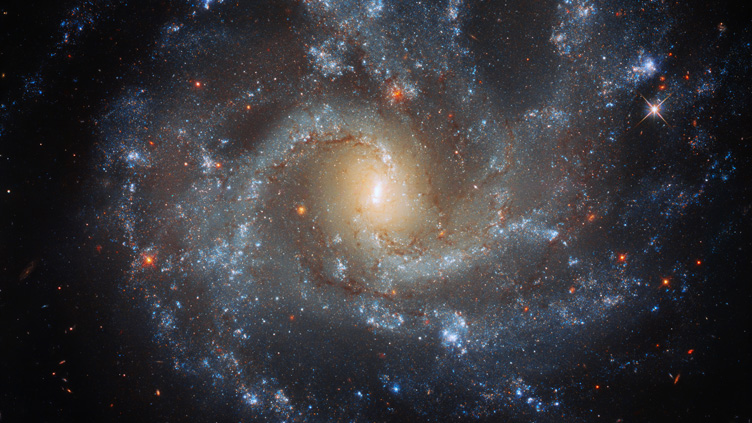In a new study lead by Instituto de Astrofísica e Ciências do Espaço (IA), researchers provided new insights into galaxy formation and evolution.
Using data from the CALIFA1 Integral Field Spectroscopy (IFS2) survey and advanced modeling tools, researchers from Instituto de Astrofísica e Ciências do Espaço (IA3) have obtained important results about the central spherical component (the bulge) in spiral galaxies like the Milky Way, shedding new light on our understanding of galactic evolution. The result was published in the latest issue of Astronomy & Astrophysics4.
It took several years and a lot of computational power to analyze approximately half a million spectra from a sample that covers all morphological types of non-interacting spiral galaxies. The team5 was able to measure, for the first time, the age variation of the stars in the bulge, from the center to the periphery, and understand the way this age difference relates to other galaxy properties, like the existence of Active Galactic Nuclei6 (AGN) or the total mass of stars in the galaxy.
“Our recent study lends support to the hypothesis that the least massive galaxies, which are now actively forming stars in the very center of their bulges, currently resemble a scaled-down version of the most massive spiral galaxies at their early evolutionary stages.”
Iris Breda
This work revealed that the stellar population at the center of the most massive spiral galaxies is older than the stars at the edge of the bulge, while in low mass galaxies the opposite happens – the youngest stars populate the center of the bulge, and the older are in the periphery. This result is in agreement with a previous study by the team, which had already found strong evidence for a unified scenario for the formation of spiral galaxies. Contrary to what is established, low and high mass spiral galaxies appear to be formed in the same manner, although high mass galaxies pass the same formation stages earlier and quicker than their lower mass counterparts.

These measurements can be used to estimate the impact of an AGN, on bulge (and therefore galactic) evolution. The fact that the mass of a bulge is tightly connected to that of the super massive black hole that powers the AGN, points to an intimate physical link between the growth of galaxies and their super massive black holes. Understanding bulge formation and evolution is therefore indispensable for the understanding of how super massive black holes were born in the Era of Reionization7 and how they influenced the evolution of galaxies.
According to IA researcher Iris Breda, the leading author of the paper: “There are many important lessons one can take from our study, the most relevant one being that bulges that are hosted by massive spiral galaxies cannot have formed in a quick and violent star-formation episode as it is commonly thought. To the contrary, these results support a scenario where these bulges are formed gradually within 2 to 4 billions of years.”
Breda, who developed most of this work during her recently finished PhD at IA and the Science Faculty of the University of Porto, concludes: “Together with our previous results, our recent study lends support to the hypothesis that the least massive galaxies, which are now actively forming stars in the very center of their bulges, currently resemble a scaled-down version of the most massive spiral galaxies at their early evolutionary stages.”
To FCT investigator Polychronis Papaderos, leader of the thematic line The assembly history of galaxies resolved in space and time at IA: “An AGN evacuates the bulge from cold gas, therefore shuts off star formation, first in its central part and, as time progresses, also in its periphery. This phenomenon results in a decrease in the mean age of stellar populations as we move from the center to the periphery of the bulge. By taking advantage of this fact, we invented a method to estimate the average velocity for the inside-out star formation quenching driven by the AGN. The relatively low velocity we infer (1-2 km/s) implies that the rise of AGN activity does not lead to a catastrophic episode of sudden removal of gas and an abrupt termination of star formation throughout the bulge.”
The leading participation of IA’s team in radio surveys, such as the “Evolutionary Map of the Universe” (EMU), offers ideal conditions for an unprecedented detailed study of the interaction of AGN with the ambient gas in galactic nuclei through deep radio-interferometry. This will allow them to look for small-scale radio-jets in bulges, which they believe went undetected from previous low-resolution radio interferometry observations.
The study of AGN activity since the Era of Reionization and its impact on galaxy evolution constitutes one of the main axes of research at IA.
To IA coordinator José Afonso (IA & Science Faculty of the University of Lisbon): “The finer details of galaxy formation and evolution are finally being explored, aligning unprecedented observations with revolutionary computational tools and modelling. These techniques will soon be taken to the next level, as we will be installing a new, powerful spectrograph, MOONS, at ESO’s Very Large Telescope. We will then have access to detailed observations of millions of galaxies during the heyday of galaxy evolution in the Universe, when the Universe was less than half its current age. IA researchers will be there, exploring those new observations and helping to better understand the assembly history of galaxies.”
Notes
- The Calar Alto Legacy Integral Field spectroscopy Area (CALIFA) survey is a project conceived at the Instituto de Astrofísica de Andalucía (IAA-CSIC) and carried out at the Calar Alto Observatory (Almeria, Spain) with the 3.5 meter reflecting telescope, using Integral Field Unit (IFU) spectroscopy. CALIFA is the first IFU survey to make its data public.
- In Integral Field Spectroscopy, the signal from each pixel on the detector is sent into a spectrograph, which then generates a spectrum, allowing for the simultaneous recording of thousands of spectra per galaxy, thus producing a spatially resolved three dimensional view of its stars and ionized gas.
- The Instituto de Astrofísica e Ciências do Espaço (Institute of Astrophysics and Space Sciences – IA) is the reference Portuguese research unit in this field, integrating researchers from the University of Lisbon and the University of Porto, and encompasses most of the field’s national scientific output. It was evaluated as “Excellent” in the last evaluation of research and development units undertaken by Fundação para a Ciência e Tecnologia (FCT). IA’s activity is funded by national and international funds, including FCT/MCES (UID/FIS/04434/2019).
- The article “Stellar age gradients and inside-out star formation quenching in galaxy bulges” was published in the journal Astronomy & Astrophysics (Vol. 635, A177, 31 March 2020, (https://www.doi.org/10.1051/0004-6361/201937193)
- The team is: Iris Breda (Instituto de Astrofísica e Ciências do Espaço & Faculdade de Ciências da Universidade do Porto), Polychronis Papaderos (Instituto de Astrofísica e Ciências do Espaço), Jean Michel Gomes (Instituto de Astrofísica e Ciências do Espaço), José Manuel Vílchez (Instituto de Astrofísica de Andalucía (CSIC)), Bodo L. Ziegler (Dep. of Astrophysics, U. Vienna), Michaela Hirschmann (DARK, Niels Bohr Institute, U. Copenhagen), Leandro S. M. Cardoso (Dep. Matemática, U. Évora), Patricio Lagos (Instituto de Astrofísica e Ciências do Espaço) and Fernando Buitrago (Instituto de Astrofísica e Ciências do Espaço & Dep. Física, Faculdade de Ciências da Universidade de Lisboa).
- Super massive black holes (SMBH) are believed to exist in the center of every large galaxy. Usually these SMBH are quiet, but if they have material falling into them at high speeds, the accretion disks formed around them emit huge amounts of radiation in all wavelengths, forming what is known as Active Galactic Nuclei (AGN). AGNs are more brilliant that the rest of the galaxy combined.
- The Era of Reionization is the second major phase transition in the Universe, right after the recombination era (around 300 thousand years after the Big Bang). Around 200 million years after the Big Bang, the first stars started forming in the first galaxies. The radiation emitted by these stars ionized the abundant neutral hydrogen in the Universe, rendering it semi-opaque. This started the era of reionization, which ended around 700 million years after the Big Bang.
Contacts
Iris Breda ; Polychronis Papaderos
Science Communication Group
Ricardo Cardoso Reis ; Sérgio Pereira ; João Retrê (Coordination, Lisboa) ; Daniel Folha (Coordination, Porto)


